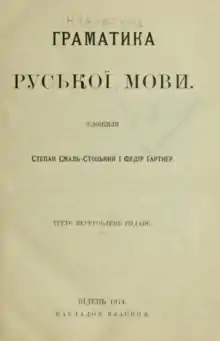羅塞尼亞語
羅塞尼亞語即古盧森尼亞语是古東斯拉夫語的語言變體,最初在立陶宛大公國被使用,後期在波蘭立陶宛聯邦的東斯拉夫地區被使用。書寫語文被稱作。[1]
| 羅塞尼亞語 | |
|---|---|
| 古盧森尼亞语 руский языкъ ruskij jazykŭ | |
| 母语国家和地区 | 波蘭立陶宛聯邦(1699年前立陶宛大公國的行政語文) |
| 語言滅亡 | 演化成白俄罗斯语、乌克兰语及卢森尼亚语. |
| 語系 | |
| 語言代碼 | |
| ISO 639-3 | – |
| 语言学家列表 | orv-olr |
| Glottolog | None |

斯蒂潘·斯馬爾·斯多茨基編著的羅塞尼亞語語法
學者們對於羅塞尼亞語是否屬於古東斯拉夫語的西方方言意見不一,但他們一致認為羅塞尼亞語與它有著密切的親緣關係。古東斯拉夫語是10至13世紀的基辅罗斯的通族語言。[2]羅塞尼亞語被視為現代白俄罗斯语、卢森尼亚语和乌克兰语的前身,事實上由古東斯拉夫語至卢森尼亚语,這些語言都被標籤為羅塞尼亞語(烏克蘭語:)。
註釋
- e.g., Elana Goldberg Shohamy and Monica Barni, Linguistic Landscape in the City (Multilingual Matters, 2010: ISBN 1847692974), p. 139: "[The Grand Duchy of Lithuania] adopted as its official language the literary version of Ruthenian, written in Cyrillic and also known as Chancery Slavonic"; Virgil Krapauskas, Nationalism and Historiography: The Case of Nineteenth-Century Lithuanian Historicism (East European Monographs, 2000: ISBN 0880334576), p. 26: "By the fifteenth and sixteenth centuries Chancery Slavonic dominated the written state language in the Grand Duchy of Lithuania"; Timothy Snyder, The Reconstruction Of Nations: Poland, Ukraine, Lithuania, Belarus, 1569-1999 (Yale University Press, 2004: ISBN 030010586X), p. 18: "Local recensions of Church Slavonic, introduced by Orthodox churchmen from more southerly lands, provided the basis for Chancery Slavonic, the court language of the Grand Duchy."
- Ukrainian language 页面存档备份,存于, Encyclopædia Britannica
參考文獻
- Brogi Bercoff, Giovanna: “Plurilingualism in Eastern Slavic culture of the 17th century: The case of Simeon Polockij.” In: Slavia: Časopis pro slovanskou filologii, vol. 64. p. 3-14.
- Danylenko, Andrii: "'Prostaja mova', 'Kitab', and Polissian Standard". In: Die Welt der Slaven LI (2006), no. 1, p. 80-115.
- Danylenko, Andrii: "On the Name(s) of the prostaja mova in the Polish-Lithuanian Commonwealth," In: Studia Slavica Hung., 51/1-2 (2006),p. 97-121
- Dingley, Jim [James]. “The two versions of the Gramatyka Slovenskaja of Ivan Uževič.’ In: The Journal of Byelorussian Studies, 2.4 (year VIII), p. 369-384.
- Frick, David A. "'Foolish Rus': On Polish civilization, Ruthenian self-hatred, and Kasijan Sakovyč." In: Harvard Ukrainian studies 18.3/4 (1994), p. 210-248.
- Martel, Antoine. La langue polonaise dans les pays ruthènes: Ukraine et Russie Blanche 1569/1667. Lille 1938.
- Moser, Michael: "Mittelruthenisch (Mittelweißrussisch und Mittelukrainisch): Ein Überblick." In: Studia Slavica Academiae Scientiarum Hungaricae 50 (2005), no. 1-2, p. 125-142.
- Mozer [= Moser], Michaėl’. "Čto takoe 'prostaja mova'?". In: Studia Slavica Academiae Scientiarum Hungaricae 47.3/4 (2002), p. 221-260.
- Pivtorak, Hryhorij. “Do pytannja pro ukrajins’ko-bilorus’ku vzajemodiju donacional’noho periodu (dosjahnennja, zavdannja i perspektyvy doslidžen’)”. In: Movoznavstvo 1978.3 (69), p. 31-40.
- Pugh, Stefan M.: Testament to Ruthenian. A Linguistic Analysis of the Smotryc’kyj Variant. Cambridge 1996 (= Harvard Series of Ukrainian Studies).
- Shevelov, George Y. “Belorussian versus Ukrainian: Delimitation of texts before A.D. 1569”. In: The Journal of Byelorussian Studies 3.2 (year 10), p. 145-156.
- Stang, Christian: Die westrussische Kanzleisprache des Grossfürstentums Litauen. Oslo 1935 (= Skrifter utgitt av Det Norske Videnskaps-Akademi i Oslo, Historisk-filosofisk Klasse 1935,2).
- Strumins’kyj, Bohdan. “The language question in the Ukrainian lands before the nineteenth century”. In: Aspects of the Slavic language question. Ed. Riccardo Picchio, Harvey Goldblatt. New Haven 1984, vol. 2, p. 9-47.
This article is issued from Wikipedia. The text is licensed under Creative Commons - Attribution - Sharealike. Additional terms may apply for the media files.